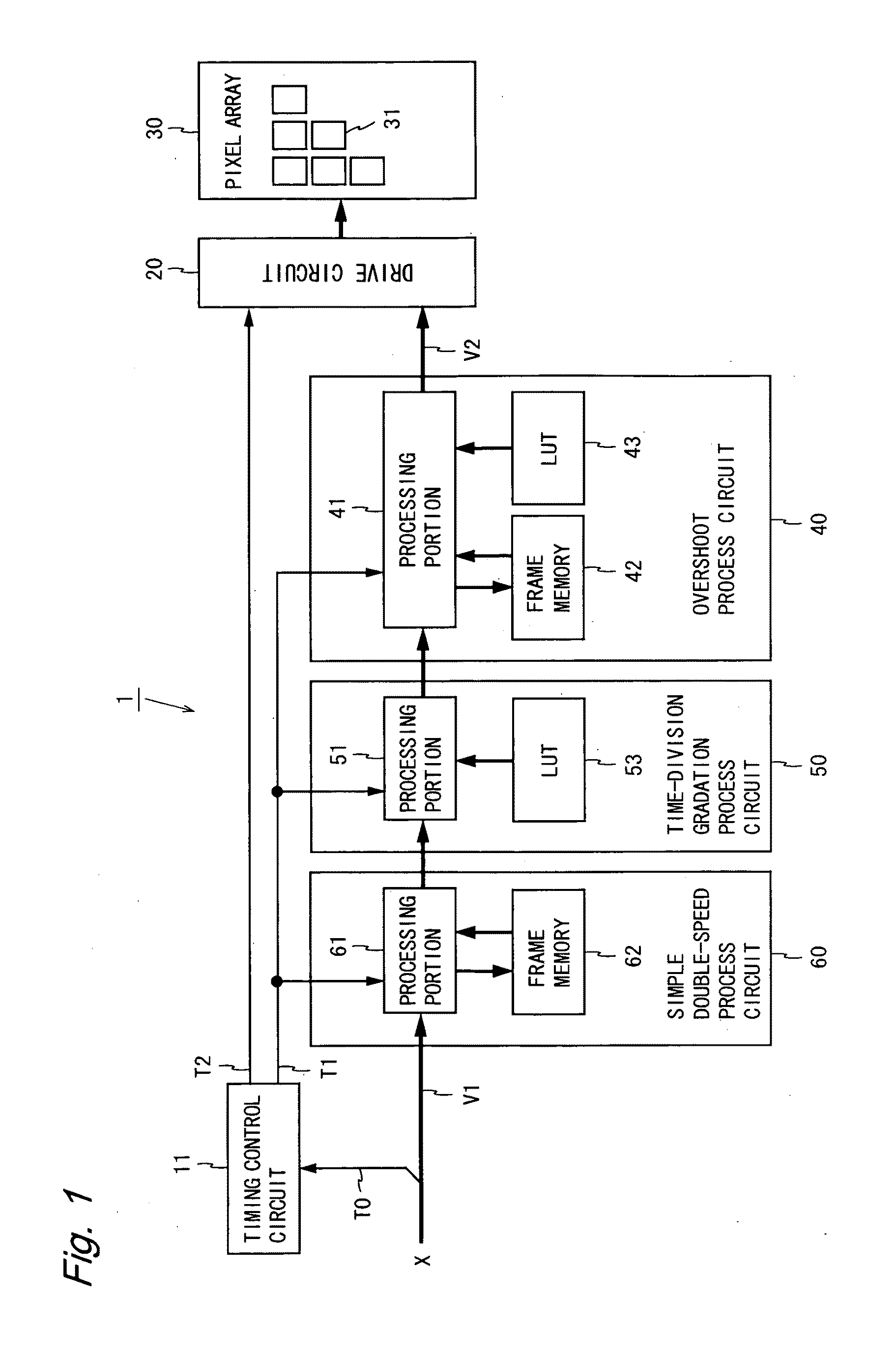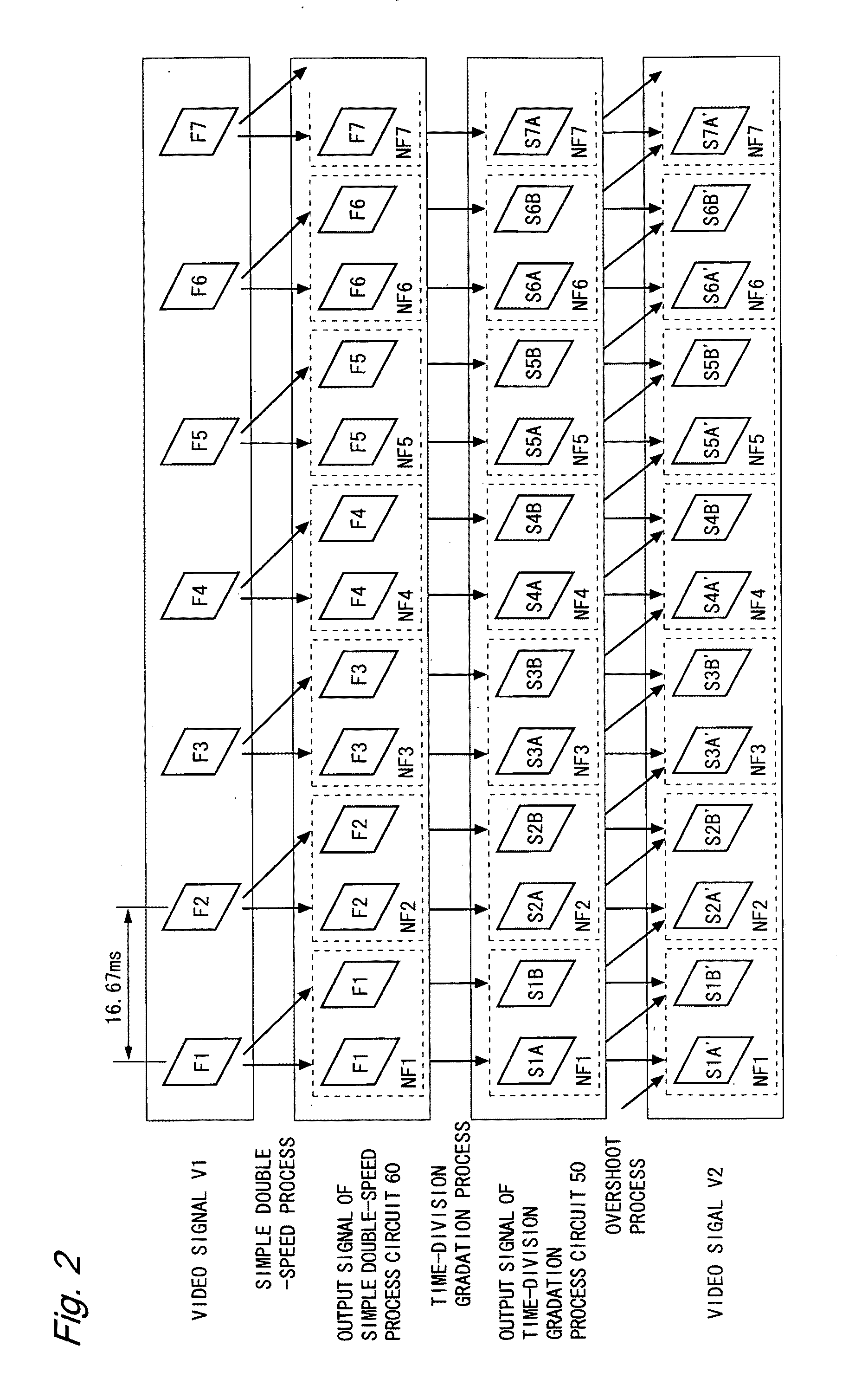Image display device
a technology of image display and display screen, which is applied in the direction of television systems, signals with optical-mechanical scanning, instruments, etc., can solve the problems of blurry visual perception of borders with different display brightness, achieve the effect of improving the display performance of moving images, and suppressing the occurrence of any moving image blur
- Summary
- Abstract
- Description
- Claims
- Application Information
AI Technical Summary
Benefits of technology
Problems solved by technology
Method used
Image
Examples
first embodiment
[0081]FIG. 1 is a block diagram illustrating the configuration of a liquid crystal display device according to a first embodiment of the present invention. The liquid crystal display device 1 shown in FIG. 1 includes a timing control circuit 11, a drive circuit 20, a pixel array 30, an overshoot process circuit 40, a time-division gradation process circuit 50, and a simple double-speed process circuit 60. The liquid crystal display device 1 performs three processes (a simple double-speed process, a time-division gradation process, and an overshoot process) on a video signal V1, and provides a gradation display using a resultant video signal V2. In the present embodiment, the simple double-speed process circuit 60 constitutes a video conversion circuit for obtaining a video signal in units of sub-frames based on a video signal inputted in units of frames.
[0082]An input signal X to be supplied to the liquid crystal display device 1 includes the video signal V1 representing image data,...
second embodiment
[0109]FIG. 12 is a block diagram illustrating the configuration of a liquid crystal display device according to a second embodiment of the present invention. The liquid crystal display device 2 shown in FIG. 12 includes a timing control circuit 12, a drive circuit 20, a pixel array 30, an overshoot process circuit 40, a time-division gradation process circuit 50, a simple double-speed process circuit 60, and a frame interpolation process circuit 70. The liquid crystal display device 2 performs four processes (a frame interpolation process, a simple double-speed process, a time-division gradation process, and an overshoot process) on a video signal V1, and provides a gradation display using a resultant video signal V2. In the present embodiment, the simple double-speed process circuit 60 and the frame interpolation process circuit 70 constitute a video conversion circuit for obtaining a video signal in units of sub-frames based on a video signal inputted in units of frames. In the pr...
third embodiment
[0119]FIG. 18 is a block diagram illustrating the configuration of a liquid crystal display device according to a third embodiment of the present invention. The liquid crystal display device 3 shown in FIG. 18 includes a timing control circuit 13, a drive circuit 20, a pixel array 30, an overshoot process circuit 40, a time-division gradation process circuit 50, and a frame interpolation process circuit 70. The liquid crystal display device 3 performs three processes (a frame interpolation process, a time-division gradation process, and an overshoot process) on a video signal V1, and displays a screen based on a resultant video signal V2. In the present embodiment, the frame interpolation process circuit 70 constitutes a video conversion circuit for obtaining a video signal in units of sub-frames based on a video signal inputted in units of frames. In the present embodiment, the same elements as those in the above-described embodiments are denoted by the same reference characters, a...
PUM
 Login to View More
Login to View More Abstract
Description
Claims
Application Information
 Login to View More
Login to View More - R&D
- Intellectual Property
- Life Sciences
- Materials
- Tech Scout
- Unparalleled Data Quality
- Higher Quality Content
- 60% Fewer Hallucinations
Browse by: Latest US Patents, China's latest patents, Technical Efficacy Thesaurus, Application Domain, Technology Topic, Popular Technical Reports.
© 2025 PatSnap. All rights reserved.Legal|Privacy policy|Modern Slavery Act Transparency Statement|Sitemap|About US| Contact US: help@patsnap.com



